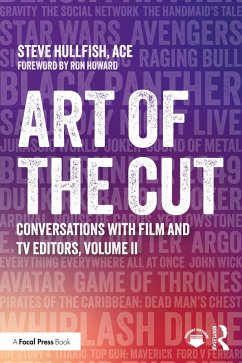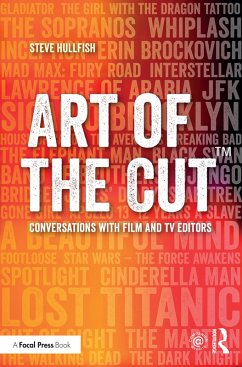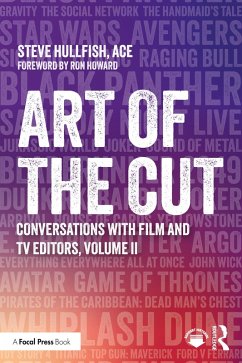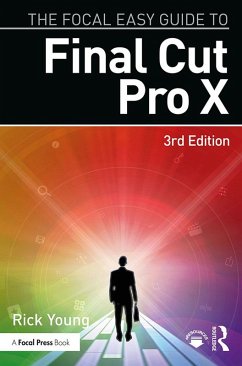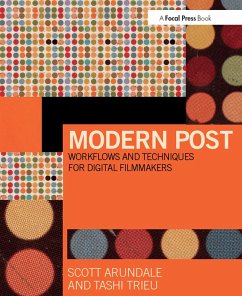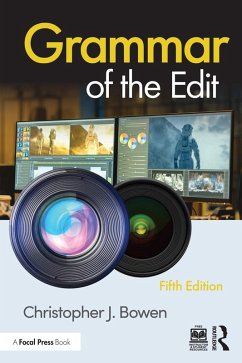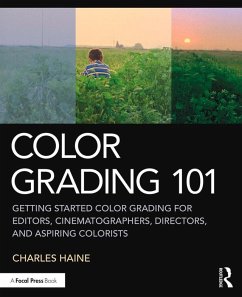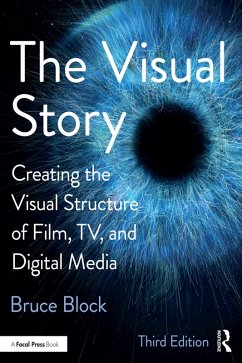
Art of the Cut (eBook, ePUB)
Conversations with Film and TV Editors
Versandkostenfrei!
Sofort per Download lieferbar
44,95 €
inkl. MwSt.
Weitere Ausgaben:

PAYBACK Punkte
22 °P sammeln!
Art of the Cut provides an unprecedented look at the art and technique of contemporary film and television editing. It is a fascinating "virtual roundtable discussion" with more than 50 of the top editors from around the globe. Included in the discussion are the winners of more than a dozen Oscars for Best Editing and the nominees of more than forty, plus numerous Emmy winners and nominees. Together they have over a thousand years of editing experience and have edited more than a thousand movies and TV shows.Hullfish carefully curated over a hundred hours of interviews, organizing them into to...
Art of the Cut provides an unprecedented look at the art and technique of contemporary film and television editing. It is a fascinating "virtual roundtable discussion" with more than 50 of the top editors from around the globe. Included in the discussion are the winners of more than a dozen Oscars for Best Editing and the nominees of more than forty, plus numerous Emmy winners and nominees. Together they have over a thousand years of editing experience and have edited more than a thousand movies and TV shows.
Hullfish carefully curated over a hundred hours of interviews, organizing them into topics critical to editors everywhere, generating an extended conversation among colleagues. The discussions provide a broad spectrum of opinions that illustrate both similarities and differences in techniques and artistic approaches. Topics include rhythm, pacing, structure, storytelling and collaboration.
Interviewees include Margaret Sixel (Mad Max: Fury Road), Tom Cross (Whiplash, La La Land), Pietro Scalia (The Martian, JFK), Stephen Mirrione (The Revenant), Ann Coates (Lawrence of Arabia, Murder on the Orient Express), Joe Walker (12 Years a Slave, Sicario), Kelley Dixon (Breaking Bad, The Walking Dead), and many more.
Art of the Cut also includes in-line definitions of editing terminology, with a full glossary and five supplemental web chapters hosted online at www.routledge.com/cw/Hullfish. This book is a treasure trove of valuable tradecraft for aspiring editors and a prized resource for high-level working professionals. The book's accessible language and great behind-the-scenes insight makes it a fascinating glimpse into the art of filmmaking for all fans of cinema.
Please access the link below for the book's illustration files. Please note that an account with Box is not required to access these files:
https://informausa.app.box.com/s/plwbtwndq4wab55a1p7xlcr7lypvz64c
Hullfish carefully curated over a hundred hours of interviews, organizing them into topics critical to editors everywhere, generating an extended conversation among colleagues. The discussions provide a broad spectrum of opinions that illustrate both similarities and differences in techniques and artistic approaches. Topics include rhythm, pacing, structure, storytelling and collaboration.
Interviewees include Margaret Sixel (Mad Max: Fury Road), Tom Cross (Whiplash, La La Land), Pietro Scalia (The Martian, JFK), Stephen Mirrione (The Revenant), Ann Coates (Lawrence of Arabia, Murder on the Orient Express), Joe Walker (12 Years a Slave, Sicario), Kelley Dixon (Breaking Bad, The Walking Dead), and many more.
Art of the Cut also includes in-line definitions of editing terminology, with a full glossary and five supplemental web chapters hosted online at www.routledge.com/cw/Hullfish. This book is a treasure trove of valuable tradecraft for aspiring editors and a prized resource for high-level working professionals. The book's accessible language and great behind-the-scenes insight makes it a fascinating glimpse into the art of filmmaking for all fans of cinema.
Please access the link below for the book's illustration files. Please note that an account with Box is not required to access these files:
https://informausa.app.box.com/s/plwbtwndq4wab55a1p7xlcr7lypvz64c
Dieser Download kann aus rechtlichen Gründen nur mit Rechnungsadresse in A, B, BG, CY, CZ, D, DK, EW, E, FIN, F, GR, HR, H, IRL, I, LT, L, LR, M, NL, PL, P, R, S, SLO, SK ausgeliefert werden.




